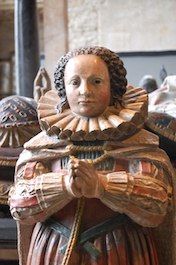Elizabeth Cary
- JOHN JANARO
England in the early 17th century was undergoing a significant religious crisis.
 Elizabeth Cary
Elizabeth Cary1585–1639
The coerced uniformity of the Elizabethan era would soon break down into war between Anglican and Puritan factions. But first there was something of a "calm before the storm." While still persecuted, the Catholic mission had some small room to breathe and grow very discreetly. Meanwhile, in Anglican ecclesiastic and academic circles there was broader discussion and a wider spectrum of opinion; more than a few were sympathetic to the Catholic position or at least willing to tolerate it. Others were opposed to all vestiges of the ancient faith, and a few began to lean toward skepticism and rationalism.
It was this somewhat fluid and intellectually vital milieu in which Elizabeth Tanfield Cary lived and found her way to the Catholic Church. Elizabeth Cary was a remarkable woman in her own time. Indeed, among women or men of any period she would qualify as a genius. She was born about 1585 in Oxfordshire; in her desire to learn she outpaced her tutors almost from the beginning of her education, and she was fluent in multiple languages and widely read by the time of her marriage to Henry Cary, Viscount Falkland, in 1602. While he was absent for seven years, Elizabeth continued to read and write extensively (including her highly regarded play The Tragedy of Mariam). Mostly, she sought religious truth in her studies. After rejecting Calvin, she was lead by Richard Hooker's high church Anglican theology to a careful study of Saint Augustine and other Church Fathers. By age twenty she was convinced that the Catholic Church was true, at least in the sense that it was the most safe and secure place to find salvation. Nevertheless, she didn't know any Catholics, so she assumed her only practical option was to remain Anglican.
When Henry Cary finally assumed his marital duties in 1608, life changed for Elizabeth. Between 1609 and 1623 she bore eleven children. In 1622, Lord Henry became Viceroy to Ireland. In Dublin, Elizabeth met practicing Catholics for the first time, particularly the remarkable and venerable Baron Dermod O'Brien. Returning to London before her husband, Elizabeth was spontaneously drawn to the community of Catholics surrounding the Irish Earl of Ormonde, Walter Butler, in Drury Lane. Among them were several Benedictines who carried out a quiet ministry, and in 1626 Elizabeth made her confession and was received into full communion with the Catholic Church.
For Elizabeth Cary — scholar, poet, wife, mother, and now Catholic — this was only the beginning of a period of remarkable trials and adventure. Though she sought no publicity, her Anglican acquaintances informed King Charles I of her conversion, which resulted in a public scandal, estrangement from her husband and (for a time) her children, and struggles with poverty. Elizabeth Cary would eventually gain back custody of her youngest four daughters and two sons, and endeavor to foster a home environment and social life that would open them up to accepting the Catholic faith, which they did before her death in 1639. The four daughters all became Benedictine nuns at Cambrai, and one of them wrote the biography of her mother. The Lady Falkland: Her Life is a vivid literary work in its own right that brings its protagonist to life, along with many complex characters (and a few saintly ones) during this dramatic period of English history.
 This is Meaghen Gonzalez, Editor of CERC. I hope you appreciated this piece. We curate these articles especially for believers like you.
This is Meaghen Gonzalez, Editor of CERC. I hope you appreciated this piece. We curate these articles especially for believers like you.
Please show your appreciation by making a $3 donation. CERC is entirely reader supported.

Acknowledgement
 John Janaro. "Elizabeth Cary." Magnificat (2020).
John Janaro. "Elizabeth Cary." Magnificat (2020).
Reprinted with permission of Magnificat.
The Author

 John Janaro is Associate Professor Emeritus of Theology at Christendom College. He is a Catholic theologian, and a writer, researcher, and lecturer on issues in religion and culture. He is the author of Never Give Up: My Life and God's Mercy and The Created Person and the Mystery of God: The Significance of Religion in Human Life. He is married to Eileen Janaro and has five children.
John Janaro is Associate Professor Emeritus of Theology at Christendom College. He is a Catholic theologian, and a writer, researcher, and lecturer on issues in religion and culture. He is the author of Never Give Up: My Life and God's Mercy and The Created Person and the Mystery of God: The Significance of Religion in Human Life. He is married to Eileen Janaro and has five children.


